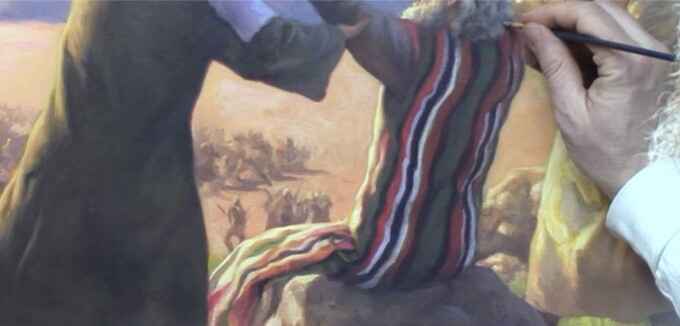- You are here:
- Home »
- Blog »
- Video Tutorial »
- How to Add Final Nuances to Signing Process

How to Add Final Nuances to Signing Process
How do you finish your acrylic painting?
Introduction
As an artist, the final steps of completing a painting are both exciting and crucial. The finishing touches and the signing process not only conclude your artistic journey but also ensure your work stands out with a professional finish. This guide will walk you through how to add those final nuances to your painting and sign it with precision. Whether you’re an emerging artist or a seasoned professional, these techniques will help you achieve a refined and polished look for your artwork.

Understanding the Significance of Final Nuances
Final nuances are the subtle details that can significantly enhance the overall quality of your painting. These are the adjustments that fine-tune the depth, contrast, and visual impact of your work. By carefully addressing these details, you ensure that every aspect of your painting is harmonious and complete.
This tutorial highlights the process of refining a large-scale painting of the biblical Battle of Rephidim. This step involves evaluating the painting for any areas needing improvement, enhancing shadows and highlights, and smoothing out any inconsistencies.
Step-by-Step Guide to Adding Final Nuances
- Assess Your Painting: Start by stepping back and evaluating your painting from a distance. Look for areas that appear inconsistent or unfinished. This assessment will guide you in making necessary adjustments. In the video, the artist scrutinized the painting for any missed opportunities and areas needing more contrast.
- Enhance Shadows and Highlights: Deepening shadows and brightening highlights can add depth and dimension to your painting. Use a combination of darker and lighter shades to enhance these areas. The artist employed raw umber, burnt sienna, and other colors to improve shadow details and highlight areas.
- Refine Glazes: If your painting has areas with uneven or rough glazes, address them by applying a semi-opaque glaze. Mixing a bit of white with your existing glaze can help smooth out imperfections. This technique ensures a seamless and polished finish.
- Detail Work: Focus on intricate details that require refinement, such as facial expressions or textures in the background. Using a fine script liner brush, as demonstrated in the video, allows for precise and detailed work, enhancing the overall look of the painting.
- Warm Up Transitions: Smooth transitions between dark and light areas can make your painting appear more cohesive. Adding warmer tones to transition points can help achieve a more natural and appealing gradation.
The Signing Process
Signing your painting is a crucial step that signifies the completion of your artwork. Here’s how to ensure your signature is both effective and professional:
- Select the Ideal Color: Choose a color for your signature that contrasts with the background without overpowering the painting. I used a mix of burnt sienna and green to create a neutral color that blends well yet stands out.
- Use the Right Brush: A fine-tipped brush, such as a script liner brush, is essential for a clean and precise signature. This type of brush holds a lot of paint and offers fine control for a professional finish.
- Positioning Your Signature: Place your signature in a location that balances the composition of the painting. The artist chose the left side to avoid disrupting the visual weight of the right side, creating a balanced and harmonious appearance.
- Include the Date: Adding the date to your signature not only marks the completion of your work but also helps in maintaining a record of your artwork. This detail adds to the professional quality of your painting.
- Final Touches: After signing, review your painting one last time to ensure everything is in place. Make any final adjustments to the signature or painting as needed to achieve a flawless finish.
Adding final nuances and signing your painting are integral steps in achieving a professional-quality finish. By carefully refining your artwork and signing it with intention, you ensure that your painting not only reflects your artistic vision but also stands out with a polished and refined look.
For more tips on painting techniques and finishing touches, explore www.realisticacrylic.com. Our tutorials and free guides resources are designed to help you perfect your craft and elevate your artwork to new heights. Happy painting!
- Sketching Your Painting Accurately
- Beginning a Pet Portrait in Acrylic
- The Mystery of Realism in Painting
- Apply A Burnt Sienna Glaze to a Portrait
- Learn How to Sketch a Portrait Freehand in 45 Minutes
- Adding highlights to your acrylic painting
- 5 Excellent Reasons to Use Aluminum Foil
- Paint Realistic Wrinkles in Acrylic
- Painting Clothing in an Acrylic Portrait
- Paint a Cloudy Sky Acrylic
- How to add Semi-Opaque Highlights
- How to Enhance the Contrast in Your Acrylic
- How to Add Glaze to Your Acrylic Painting
- Paint Realistic Reflections on Eyeglasses in an Acrylic Portrait
- Build Up Depth on Your Acrylic Portrait Backgrounds
- How Do You Do Layers With the Glazing Technique?
- Learn How to Paint Wrinkles in Acrylic
Read more about how to paint a portrait that you can surely be proud of!
I’d love to hear your thoughts on this video. Please share it with your friends and family. Let me know if you have any further questions. I’ll greatly help you.
If you’d like to learn more, sign up for my free email tips and video class today.
Learn How to Paint Acrylic Portraits With My Free Mini-Video Course!
Thank you so much for taking the time to read this tutorial and watch the video. That means a lot to me. I hope you find it very helpful in your portrait painting.
Yours for Better Portraits,

P.S. Did you find this post helpful or encouraging? If so, send it in ahead! Let others know with the share buttons below. I’d love to hear your comments. Thank you so much! Also, do you have a question on acrylic portrait painting you’d like answered? Let me know, and I’d be happy to help!
